Written by John-Paul Quinn – @AttackingCB
Steve Bruce’s Newcastle remain in a relatively comfortable league position, despite not looking like a very good football team. I wrote last month about how they appear to have regressed in every area (bar points) from last season. Since then, they have beaten Chelsea with a last-minute winner and scored 2 goals in the 94th and 95th minutes to salvage a point against Everton, after clearly being second-best in both games.
The expected goals numbers continue to move in the wrong direction, with the xG against figure now significantly higher than at any point in the last 2 years. Much of the criticism of Bruce has been aimed at the attacking side, which is clearly an issue – only Crystal Palace have scored fewer than Newcastle’s 24 goals – but they are far from solid defensively either, as demonstrated by a 4-0 defeat at the Emirates on Sunday. Only Norwich have a worse goal difference.
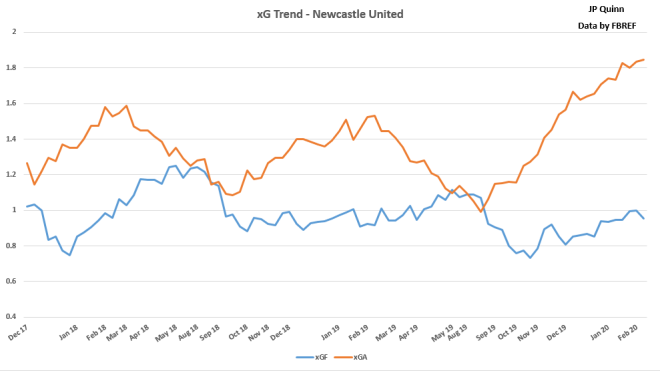
There has been an interesting conversation recently about Liverpool’s xG, as most models seem to underrate them, suggesting Man City might still be the better team despite Liverpool’s 22 point lead at the top of the table. One explanation for their over-performance can be demonstrated by a post-shot xG model which suggests that the opposition have been taking worse shots (which may or may not be down to something Liverpool are consciously doing). However, it is worth pointing out that on FBREF’s post-shot model, on the defensive side at least, Newcastle’s numbers get worse, not better.
What else is notable is that Newcastle have only ‘won’ on xG ONCE this season – at home to Bournemouth (which they actually won 2-1).
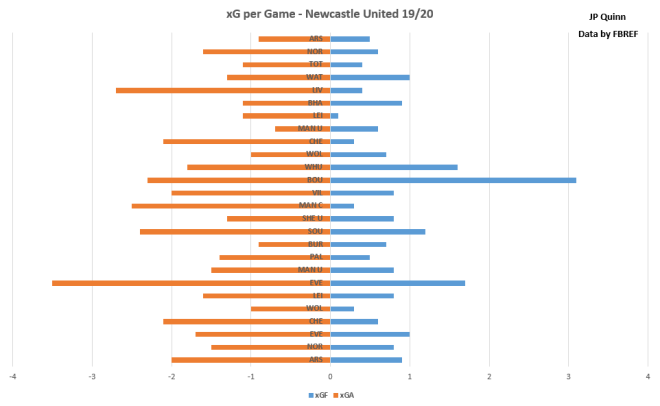
This is where the ridiculously low expected points figure comes from, when looking at the ‘most likely result’, Newcastle would only pick up 3 points once. If you were to use an ‘average points’ method it would be kinder, but still not pleasant viewing.
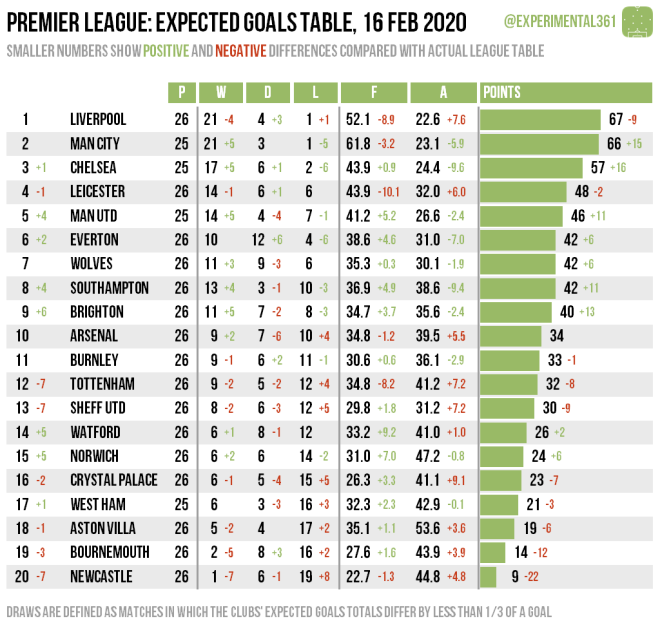
Taken from experimental361.com – produced by Ben Mayhew.
Last season Newcastle ‘won’ 13 of 38 games on xG, which is closer to what you would expect for a team that finished 13th and actually won 12 games. So if Bruce is largely sticking to the same style and system (a defensive 5-4-1) and has much the same players (certainly on the defensive side), why such a contrast in output?
The possession stats start to give an indication of what has changed:

Last season, Newcastle averaged 40.1% possession, which is pretty low, but this season the average has dropped significantly to 34.7%. They have only had more possession than their opposition once this season – against Burnley, who average the second-lowest possession in the league. Last season they did it 10 times.
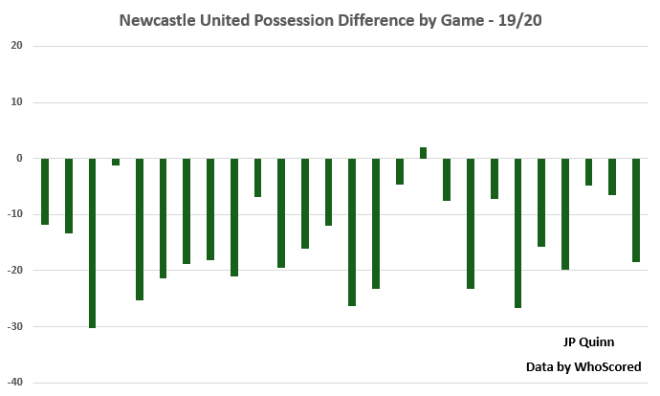
There’s certainly a consistency to it – there may be an argument that if that’s the way you want to play and you’re good at it, why alter it?
Next, we look at the pressing stats. PPDA stands for passes per defensive action (in the opposition half) and is a measure of pressing – a lower number indicating a more pressing team.
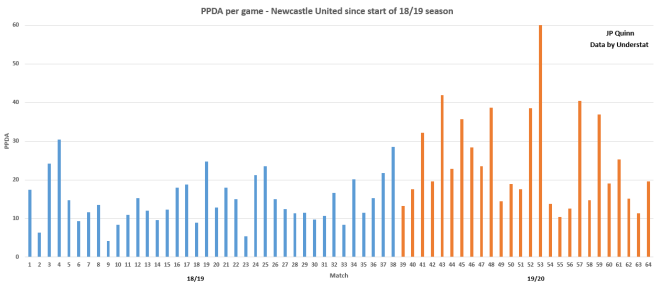
Here we see a dramatic increase in the average (from 14.7 to 24.7), and we start to see some really high numbers. Newcastle were one of the least-pressing teams in the league last season but this season they are THE least-pressing BY FAR. Under Rafa, we saw some very deep defending against the likes of Man City and Liverpool (indeed he was often criticised for it) but there were also times where they would play more pro-actively against weaker opposition. The current team doesn’t seem capable of that.
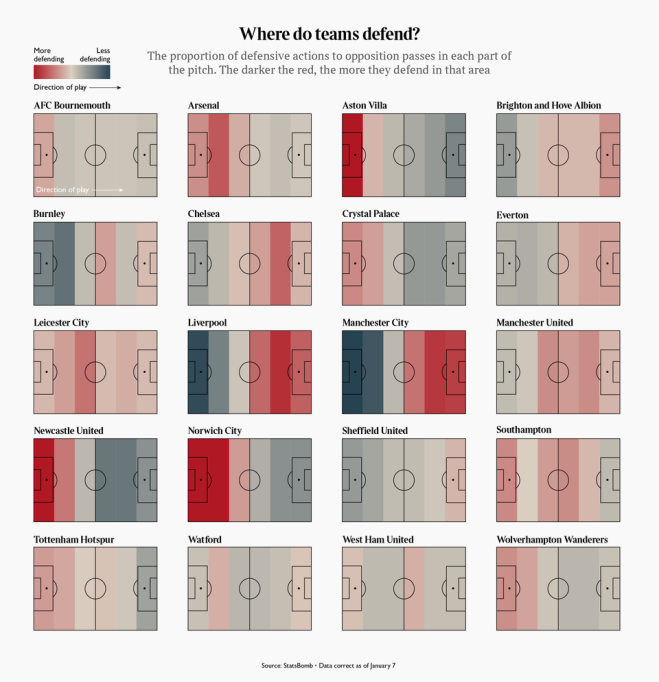
Source: Statsbomb
This lack of pressing means you are constantly defending in and around your own box – only Norwich and Aston Villa are comparable in how deep they defend. It invites pressure but also makes it harder to transition into attack and harder to sustain those attacks. If you can win the ball higher up the pitch, you have more chance of a dangerous attack, rather than starting from the edge of your own box. Something Liverpool and Man City have had great success with – not just winning the ball back but winning it *in dangerous positions*. Think Sean Longstaff nicking the ball off Fernandinho in his own box and winning a penalty at St. James’ Park (and that was against Man City). That doesn’t seem to happen this season.
From open play there’s a reliance on Saint-Maximin or Almirón to dribble their way into a dangerous position but it’s often an individual effort rather than a collective – they and Joelinton are too often isolated. The team’s lack of ability to progress the ball into dangerous positions is reflected by the fact they play fewer passes into the box than any other team in the league.

The other issue is what happens when Newcastle go behind, when they need to chase the game, what is the plan? Bruce has repeatedly said that every time the team opens up a bit, they start to look ragged defensively (and he’s not wrong).
There were concerns when Bruce was appointed that he would move away from the solid base that Benítez had built. There was talk of playing a more ‘font-foot’ style but in fact he has done the opposite. This is a more extreme version of Rafa’s defensive model and, as is increasingly clear, an inferior version. Bruce has also said that the players don’t know how to play any other way or that they aren’t capable, that he is basically stuck with this system and tactical set-up for now, but the numbers show that they were capable of a different approach last season.